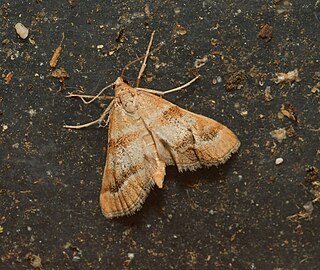
Metasia is a genus of moths of the family Crambidae. They are found mainly in Europe and Australia, but also in Africa, Asia, North America, and Pacific islands.

Metasia achroa is a species of moth of the family Crambidae described by Oswald Bertram Lower in 1903. It is known from Australia.
Metasia gigantalis is a species of moth in the family Crambidae. It is found in Greece, the Republic of Macedonia and on Cyprus, Crete and Sicily.

Metasia corsicalis is a species of moth in the family Crambidae. It is found in France, Spain, Italy, Croatia and on Corsica, Sardinia, Sicily and Malta.

Metasia cuencalis is a species of moth in the family Crambidae. It is found in France, Spain and Portugal, as well as in North Africa, including Morocco.
Metasia hymenalis is a species of moth in the family Crambidae. It is found in France and Spain, as well as North Africa and Iran.

Metasia suppandalis is a species of crambid snout moth in the family Crambidae. It is found in southern Europe, North Africa, and southwestern Asia.
Metasia harmodia is a moth in the family Crambidae. It was described by Edward Meyrick in 1887. It is found in Australia, where it has been recorded from Western Australia.
Metasia hemicirca is a moth in the family Crambidae. It was described by Edward Meyrick in 1887. It is found in Australia, where it has been recorded from Tasmania.
Metasia homogama is a moth in the family Crambidae. It was described by Edward Meyrick in 1887. It is found in Australia, where it has been recorded from Western Australia.
Metasia xenogama is a moth in the family Crambidae. It was described by Edward Meyrick in 1884. It is found in the Australian states of South Australia and Western Australia.
Metasia inustalis is a moth in the family Crambidae. It was described by Ragonot in 1894. It is found in Turkey, Iraq and Iran.
Metasia asymmetrica is a moth in the family Crambidae. It was described by Hans Georg Amsel in 1970 and is found in Afghanistan.
Metasia bilineatella is a moth in the family Crambidae. It was described by Hiroshi Inoue in 1996. It is found in Japan, where it has been recorded from Ogasawara Islands.
Metasia homophaea is a moth in the family Crambidae. It was described by Edward Meyrick in 1885. It is found in Australia, where it has been recorded from New South Wales.
Metasia orphnopis is a moth in the family Crambidae. It was described by Turner in 1915. It is found in Australia, where it has been recorded from Queensland.
Metasia pharisalis is a moth in the family Crambidae. It was described by Francis Walker in 1859. It is found in Australia, where it has been recorded from Queensland.
Metasia triplex is a moth in the family Crambidae. It was described by Turner in 1913. It is found in Australia, where it has been recorded from Queensland.
Metasia typhodes is a moth in the family Crambidae. It was described by Turner in 1908. It is found in Australia, where it has been recorded from Queensland.
Metasia zophophanes is a moth in the family Crambidae. It was described by Turner in 1937. It is found in Australia, where it has been recorded from Queensland.





